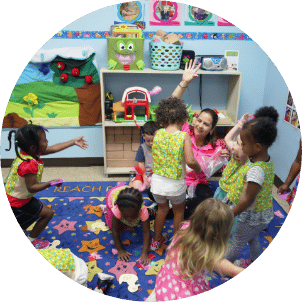Why Early Talk?
Every interaction counts in early childhood education.
Increasing adult-child interaction is among the easiest and most cost-effective ways to improve children’s futures. Unfortunately, children experience significantly less adult-child interaction in child care centers than at home. That’s according to extensive data analysis from LENA, based on daylong audio recordings from over 24,000 children who have participated in LENA programs.
Here, we seek to summarize the data and to offer answers to several very big questions:
- What is the current state of adult-child interaction in early childhood education?
- Why does it matter?
- How can we work together to give early childhood educators the support they need to improve language environments equitably?
Many of these findings were first presented at the 2022 National Research Conference on Early Childhood.
Why focus on interactive talk?
In recent years, a growing body of research has explored links between early interactive talk and optimal early childhood development in infants, toddlers, and preschoolers. LENA has a name for this interactive talk between an adult and a young child: conversational turns.
Using LENA technology, researchers have reported that conversational turns are predictive of language and social-emotional development, as well as brain structure and function and IQ scores in middle school. Conversational turns have also been shown to be predictive of children's vocabulary skills in preschool settings specifically.
It's incumbent upon the educators and caregivers in children's lives to tune in and respond to them, even when their vocalizations are just babbles and grunts.
Likewise, though, it’s incumbent upon policymakers to create the circumstances under which adults, especially early childhood educators, can truly focus on responsive relationships with the children in their care, absent the mental and material hardships they so often face.

All the many milestones by which school readiness is measured are built on a foundation of trusting relationships. Trusting relationships and conversational turns go hand in hand. The time is now to put LENA technology to work everywhere, especially in early childhood education settings. Early educators deserve professional supports that motivate, inspire, and provide actionable feedback on what matters most: building nurturing relationships that help children thrive.
How much interactive talk is optimal?

A 10-year longitudinal study published by LENA’s researchers in 2018 showed that children who engaged in more conversational turns between the ages of 18 and 24 months had higher IQ scores and language skills in adolescence.
But is there a specific number of interactions that caregivers should aim for? The answer, according to the Inside Early Talk report: 40 conversational turns per hour.
Up to 40 conversational turns per hour, each increase of two turns per hour is associated with a one-point increase in Full Scale IQ. Above 40, returns diminished and the same IQ increases required greater increases in turns.
Whether young children are in the care of their parents, other primary caregivers, center-based early educators, or family child care (FCC) early educators, they should ideally be experiencing at least 40 conversational turns per hour for healthy language, cognitive, and interpersonal development.
How much interaction do children get in different settings?
If 40 conversational turns per hour is the goal, then what’s the current reality? How many interactions do children experience in different early care settings?
To put it bluntly: The difference between language environments at home and in child care centers is stark.
Data Set
Total

24,299 children
2-36 months of age
Results
Children in child care are less likely to experience optimal language environments.
At home, 29% of children experience at least 40 conversational turns per hour, compared to just 7% in center-based care*.
*This does not include Head Start. See below for more on Head Start settings.
Other takeaways:
- Children at home are four times more likely to engage in 40 conversational turns per hour than children in child care centers.
- Children in FCC settings are twice as likely to engage in 40 conversational turns per hour as children in center-based care.
- Over 80% of children in home settings experience at least 15 conversational turns per hour, compared to just 50% of children in child care centers.
A note about Quality Improvement Systems (QRIS/QIS)
Even in child care centers that have achieved their state’s highest quality rating, approximately one in four children experiences fewer than 15 conversational turns per hour.
The differences between home and child care widen as children get older.
Infants in center-based care engage in significantly more conversational turns than older children. The opposite is true of home and FCC environments, where children experience more conversational turns as they get older.
Other takeaways:
- Between 25 and 36 months of age, children in home settings experience an average of 40 conversational turns per hour, more than double what children in child care centers experience.
- Differences across settings are smallest for infants and greatest for toddlers. The differences between home and child care settings are particularly large at 18-24 months, the very age window that best predicts long-term outcomes.
Socioeconomic status predicts child care language environments.
Children living in low-SES neighborhoods engage in fewer conversational turns than children living in high-SES neighborhoods. This is true both in home settings and child care centers. The Neighborhood Atlas was used to measure SES.
An independent study from researchers at Purdue University published in the journal Infant and Child Development supports this finding about a link between SES and interaction in child care.
Other takeaways:
- Though this SES effect in child care occurs across all age groups, it is most prominent in the 18-24 month age group.
- Unlike children in low-SES home settings and high-SES home and child care settings, children in low-SES child care settings do not experience more interaction as they get older. In low-SES child care settings, two-year-olds experience approximately the same number of conversational turns as children aged 2-24 months.
A lower child-teacher ratio means more conversational turns.
In preschool and pre-K classrooms specifically (36-60 months of age), conversational turn rates are significantly higher for the smallest ratio grouping of one to five children per teacher. For the higher ratio groupings, the average classroom turn rates are somewhat similar.
Dual language learners experience fewer conversational turns.
In classrooms with only monolingual, English-speaking teachers, children who are DLLs experience significantly fewer conversational turns (-7.5 turns per hour) than their monolingual peers in the same classroom. By contrast, in classrooms with bilingual teachers, there is only a marginal difference between DLLs and monolingual children.
The gap is widest in toddler classrooms that did not have bilingual teachers, where dual language learners experience 14.7 fewer conversational turns per hour.
Approximately half of all 0-5 year olds in the U.S. attend child care.
Following an initial dip to just one in 20 at the beginning of the COVID-19 pandemic, according to the RAPID Survey Project, nearly half of all children five or younger spend time in center-based care.

Of the children who attend child care, one in five experiences language isolation.

According to analysis of over 15,000 daylong recordings, approximately one in five children experiences language isolation, even when other children in their class may experience much more interaction.
LENA’s researchers describe a child as experiencing language isolation if they engage in fewer than five conversational turns per hour for all but the single hour during which the most conversational turns occurred. That means they may experience more interaction at one specific time of the day, such as arrival time or lunch time. Otherwise, though, they experience almost no interaction with a teacher throughout the day.
Children in child care are four times more likely to experience language isolation than to experience an optimal language environment consisting of 40 conversational turns per hour.
Dual language learners are four times more likely to experience language isolation.
In a smaller sample consisting of 45 classrooms where no teachers were bilingual, a significantly higher percentage of DLL children began in language isolation compared to their monolingual classroom peers: 21% compared to 5%.
On average, interaction levels in Head Start classrooms are higher.
It's important to note that children in Head Start programs experience, on average, much more interactive talk than children in other child care centers.
- Compared to children in non-Head Start centers, children attending Head Start are almost three times more likely to experience 40 conversational turns per hour.
- Infants aged 2-11 months in Head Start experience more interaction than infants aged 2-11 months in home settings.
- Head Start effectively negates the SES effect. For children aged 0-24 months, those attending Head Start experience more conversational turns than those attending high-SES non-Head Start centers. Two-year-olds experience nearly equivalent levels of talk in the two settings.
There's still a clear opportunity to support Head Start educators in achieving even higher levels of interactive talk, and in ensuring equitable experiences for different children within single classrooms. There's also just as clear an opportunity to ask what sets Head Start apart from other child care settings.
How do we work together to increase interactive talk in early childhood education settings?
1. Amplify the importance of classroom language environments.
It goes hand in hand with advocating for systemic policy changes.
The 2020 edition of the Early Childhood Workforce Index, published by the Center for the Study of Child Care Employment (CSCCE), opens with a line that’s every bit as provocative as it is true: “Despite their important, complex labor, early educators’ working conditions undermine their well-being and … jeopardize their ability to work effectively with children.” In short, early childhood educators are underpaid and underappreciated. This undermines their ability to nurture the development of the children in their care.
Quality improvement systems, professional development programs, and curriculums must adapt to value what early educators themselves value: building relationships with children, nurturing their optimal development, and setting them up for long-term success. Very closely tied to interactive talk, these are the things that make early educators' work so immensely valuable. We must continue to demonstrate that value through objective data.
2. Listen to the research.
It reveals more about early language experiences than was ever thought possible.
The question of how child care language environments differ from home language environments is not a new one. In fact, studies published as long ago as 1977 and 1979 similarly concluded that children in child care settings experienced fewer adult-child interactions than their peers who did not attend child care.
However, LENA technology now allows greater access to reliable data on children's language experiences in child care settings than ever before. We can gain insights into more children's experiences, and we can do so for the duration of an entire day. We can also get a clear, objective picture of how each individual child experiences a classroom's language environment. One child's experience in a classroom may vary widely from another child's experience in that same classroom. Even in "high talk" classrooms, some children are left out of the conversation.
3. Implement practice-based professional development.
It motivates educators and can transform children's lives.
The data points presented above paint a clear picture of where we are. That's not enough, though. We also have to provide solutions. We have to support early educators as they paint a brighter future — for themselves and for the children. To that end, we invite you to learn more about LENA Grow, our evidence-based professional development program designed to make every interaction count in early childhood education.
LENA Grow helps early child educators increase interactions with children, build job satisfaction and self-efficacy, and improve children’s language skills and social-emotional outcomes. Two independent evaluations of LENA Grow confirm these positive results, including higher TS GOLD® scores.
Perhaps even more important than the opportunity to conduct further research, we have the immense opportunity to directly help early childhood educators themselves. Teachers can get clear and actionable feedback and coaching on how they interact with the children in their care.
This is something that could only be dreamed of in decades past. Let's work together to give as many educators as possible access to this game-changing opportunity.





